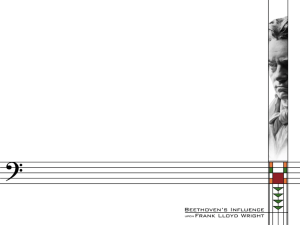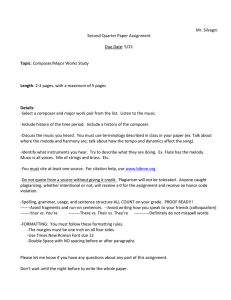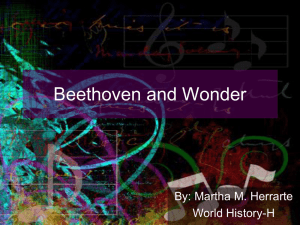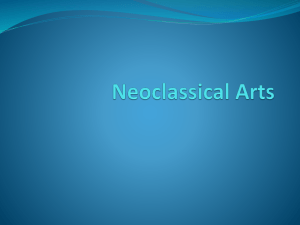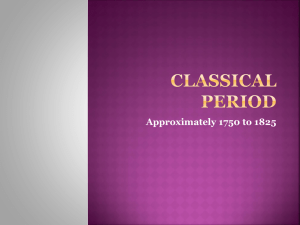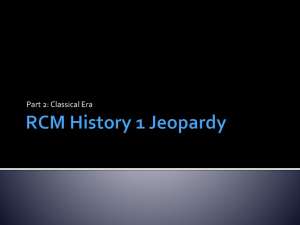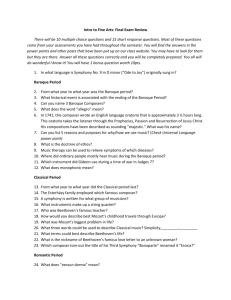! HISTORICAL AND DESCRIPTIVE ANALYSIS OF SELECTED WORKS FOR CHAMBER WINDS
advertisement
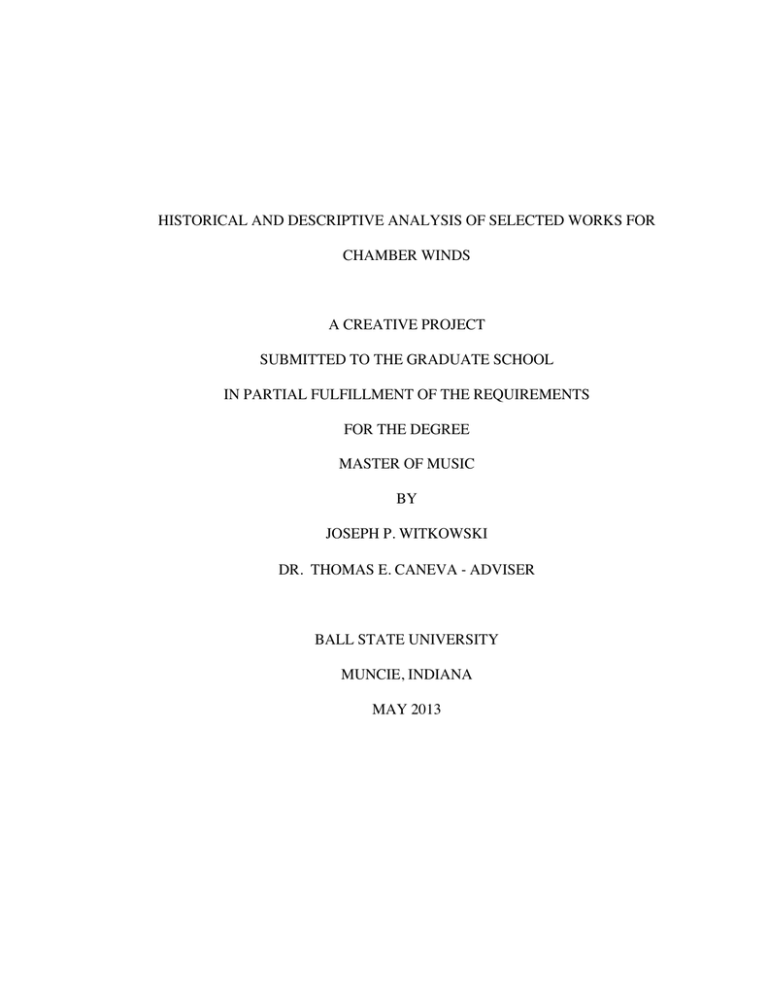
!
HISTORICAL AND DESCRIPTIVE ANALYSIS OF SELECTED WORKS FOR
CHAMBER WINDS
A CREATIVE PROJECT
SUBMITTED TO THE GRADUATE SCHOOL
IN PARTIAL FULFILLMENT OF THE REQUIREMENTS
FOR THE DEGREE
MASTER OF MUSIC
BY
JOSEPH P. WITKOWSKI
DR. THOMAS E. CANEVA ! ADVISER
BALL STATE UNIVERSITY
MUNCIE, INDIANA
MAY 2013!
INTRODUCTION
In the preparation of music for performance, the conductor must extensively study
the historical background and musical content of each coposition. The result of this
research and study for a conducting recital featuring the works Etenraku by Christopher
Theofanidis; Rondino by Ludwig van Beethoven; and Serenade No. 12 in C minor, K.
388(384a) by Wolfgang Amadeus Mozart are given in the form of extended program
notes presently. The relevant biographies of the composers are examined in addition to
the historical and musical details of each work.
!"
#"
CHAPTER 1
Etenraku by Christopher Theofanidis
Christopher Theofanidis is an American Composer who has established himself in
the contemporary music repertory. His works have been performed by numerous
orchestras and wind ensembles in North America and Europe. Born in 1967 in Dallas,
Texas, he received a bachelor of music degree from the University of Houston, master of
music from the Eastman School of Music, and the doctor of musical arts from Yale
University.
Theofanidis has been the recipient of the International Masterprize, the Rome
Prize, a Guggenheim Fellowship, and six American Association of Composers, Authors
and Publishers (ASCAP) Gould Prizes, amongst many other awards, fellowships, and
honors. Additionally, he was a member of the American Academy in Rome and has been
nominated for a Grammy.
Theofanidis’s output includes works for orchestra, chorus, wind ensemble,
chamber ensembles, and four operas and a ballet, but four of his compositions are for
ensembles of wind and percussion instruments. Those are: The Here and Now, for
soloists, chorus, and wind ensemble; Rex Tremendae Majestatis, for solo organ, brass,
and percussion; I wander the world in a dream of my own making [sic], for wind
ensemble; and Etenraku, for winds, piano, harp, and percussion.
$"
Etenraku, completed in 1996, was the result of a commission by The National
Symphony on the occasion of the twentieth anniversary of the Kennedy Center. The
commission required the use of a subsection of the orchestra in a brief work to open a
concert. Theofanidis chose the orchestra woodwind section, comprised of flute, oboe,
clarinet, and bassoon in groups of four. For the group of flutes, four players are needed
with two playing piccolo for the entire piece. In addition to the woodwinds, the
composition utilizes harp, piano, and percussion. Three players are needed cover to the
percussion contribution of toms, bells, China cymbal, temple blocks, large gong,
xylophone, and bass drum. Concerning Etenraku, Theofanidis writes:
One of the major influences on contemporary music in the past 20 years has been
world music - it has provided composers with new ways to think about phrasing,
color, and rhythm. I was so excited back in 1994 to find out about Gagaku music
from the imperial court of Japan - it is the oldest written music in the world and
has an utterly unique sound. The uses of very distinctive instruments such as the
sho [sic] (a pentatonic woodwind drone instrument that “pulsates” a beautiful
harmonic background), the hichiriki (a shawm-like instrument) and the
shakuhachi (a flute instrument with the ability to “bend” pitches), all added to the
allure. In this piece, I did a kind of short fantasy on this music, and in particular,
on one of the most famous tunes in this repertory - “Etenraku” (which means,
“music coming from heaven”).1
The gagaku music that inspired Theofanidis was traditional court music that
bourgeoned during Japan’s Heian period (794-1185).2 The composer artfully
orchestrated the work to imitate those primitive yet exotic sounds. The sh! is a Japanese
mouth organ that features 17 pipes. In much of the gagaku repertory, its part consists
""""""""""""""""""""""""""""""""""""""""""""""""""""""""
1
Christopher Theofanidis, Program notes to Electric Dawn, Columbus State University
Wind Ensemble, Summit Records DCD422, CD, 2005.
2
Kenneth Chalmers, "Gagaku," In The Oxford Companion to Music, Oxford Music
Online, February 9, 2013, http://www.oxfordmusiconline.com/.
%"
entirely of tone clusters known as aitake.3 There were ten basic aitake chords, and each
chord contained five or six notes. The chords were chosen to correspond with the main
melody note.4 In Etenraku, Theofanidis uses the clarinet to mimic the desired function
and sound of the sh!. Obviously, with the limitation of just four parts, the exact cluster
of an aitake cannot be achieved. In Etenraku, a tetrachord voiced in the clarinets is used
consisting of pitches C, D, F, and G. The tetrachord can be seen in Example 1.
Example 1: Christopher Theofanidis, Etenraku, mm. 3-5.
Like the aitake, the makeup of the chord is deliberate, based on C in the lowest voice to
correspond with melodic material. The pitch class C is ubiquitous throughout the work
and serves as a tonic, so it stands to reason that the tetrachord would be based on C. The
""""""""""""""""""""""""""""""""""""""""""""""""""""""""
3
David Hughes, "Sh!," In Grove Music Online, Oxford Music Online, February 10,
2013, http://www.oxfordmusiconline.com/.
4
Ibid.
&"
clarinet parts call for “asynchronous pulsating” to be achieved through repeated
crescendo and decrescendo dynamic fluctuations.5
The hichiriki is a Japanese oboe made of bamboo in a reverse conical shape,
unlike the modern Western oboe.6 In gagaku music, it served a melodic function, with a
continuous stream of subtle ornamentation and pitch gliding. These effects were
accomplished both by fingering techniques and by means of embouchure variation.7 In
order to achieve this type of sound for Etenraku, the oboe players must play deep on the
reed and are instructed to make a “shawm-like, nasal” sound.8 The oboe parts begin on
C, but quickly move to B-flat, which is the fifth note of the pentatonic structure the
composer utilizes as the foundation of the work. Adding that to the tetrachord
established in the clarinets and harp, complete pentatonic structure is comprised of pitch
classes C, D, F, G, and B-flat. The intervals in ascending order are whole step, minor
third (three semitones), whole step, and minor third. By avoiding half-step (i.e., single
semitone) intervals, the space necessary to slide into pitches and “bend” them is provided
for the modern instruments being utilized.
The final sound Theofanidis set out to evoke is that of the shakuhachi. The
shakuhachi is an end-blown notched flute, also of Japan.9 Ethnomusicologist William
Malm described the unique possibilities of the instrument: “From a whispering, reedy
""""""""""""""""""""""""""""""""""""""""""""""""""""""""
5
Christopher Theofanidis, Etenraku (for Woodwinds, Harp, Piano and Percussion),
(Brooklyn, NY: Opus 125 Publishing, 1996).
'"David Hughes, "Hichiriki," In Grove Music Online, Oxford Music Online, February 10,
2013, http://www.oxfordmusiconline.com/."
(")*+,-"
."/012345+,+67"!"#$%&'(-"
8""Shakuhachi," In Grove Music Online, Oxford Music Online, February 10, 2013,
http://www.oxfordmusiconline.com/.
'"
piano, the sound swells to a ringing metallic forte only to sink back into a cotton-wrapped
softness, ending with an almost inaudible grace note, seemingly an afterthought.”10 The
fundamental pitches of the standard shakuhachi are D, F, G, A, and C. It is interesting,
yet perhaps purely coincidental, that four of the five are those upon which the composer
initially structures the piece. The one that is not included, A, happens to be the highest
pitch to be performed at the loudest dynamic in the entire work. It appears, of course, at
the conclusion in the flute and piccolo. The instruction to the flute and piccolo players in
Etenraku is simply “like a shakuhachi.”11
The initial marking in the score is “Slow; Euphoric.”12 The work begins with a
fortissimo statement in the toms, which leads to the much softer establishment of the
tetrachord in the clarinets. The melodic content features the sliding motion that
characterizes the gagaku music. The percussion contribution adds to the exotic sound of
the work, especially through the use of the China cymbal and temple blocks. The temple
blocks reinforce the pentatonic structure while providing a contrasting timbre and
register.
At m. 27, the remainder of the forces enter, and the soundscape expands lower in
the tessitura with the bassoons, piano, and harp all entering three octaves below what had
been the lowest voice in the clarinet. The harmonic rhythm becomes shorter in the harp
and piano, driving the music forward. The upper voices begin to climb as they join
together in octaves and their melodic components are augmented, contrasting the harp,
""""""""""""""""""""""""""""""""""""""""""""""""""""""""
!9")*+,-"
!!"/012345+,+67"!"#$%&'(-"
!#")*+,-"
("
piano, and xylophone. Finally, the piano and harp reach a pair of nine-note clusters at m.
48, just as the piccolo, flute, and clarinet complete their ascent. The bass voices sustain
the fundamental; all at full volume, and the percussion concludes the piece, with a
fortissimo descending tom gesture, just as it began.
Theofanidis was able to take advantage of the commissioning body’s request to
use only a subsection of the orchestra and, in so doing, cleverly created a new-age
gagaku ensemble. The sounds of centuries long-since-past are re-imagined and inspired
in this modern setting of “music coming from heaven.” His skillful writing for smaller
forces is a welcome addition to the wind ensemble repertory as it provides a unique
sound for an unusual grouping of instruments.
."
CHAPTER 2
Rondino by Ludwig van Beethoven
Ludwig van Beethoven may have been the most important composer of the late
18th and early 19th centuries. He was the driving force in Western music as the art
evolved from the classical to romantic era. Born at Bonn, Germany, in 1770 to a family
that had three generations of successful musicians, Beethoven received lessons on both
violin and piano from his father beginning at a young age. His first known public
performance was at the age of six with another of his father’s pupils when, according to
the public notice, he played “various piano Concerti and Trios.”13 Although Beethoven’s
dysfunctional family and inadequate academic and social education was at odds with his
early promise as a child, he continued his studies with other musicians and became a
court musician himself at the age of twelve.
His life and works had been divided into three periods, but after years of
discussion and debate, it is now more appropriately viewed through a four-period
framework. The composer’s childhood, early life, and formative years are known as the
Bonn period, which concludes around 1792.14
""""""""""""""""""""""""""""""""""""""""""""""""""""""""
!$"H.
C. Robbins Landon, Beethoven: His Life, Work and World (New York, N.Y.:
Thames and Hudson, 1992).
!%"Joseph Kerman, et al., "Beethoven, Ludwig van," In Grove Music Online, Oxford
Music Online, February 16, 2013, http://www.oxfordmusiconline.com/.
"
8"
The early Vienna period, 1793-1802, includes his move to Vienna, time spent
learning the Viennese style, and eventually the establishment and assertion of his
individuality with respect to that style. Piano sonatas, string quartets, and his first
symphony are among the compositions he produced during this period.15
The middle period spans from 1803-12 and begins with a series of famous
compositions in the heroic vein, including the ‘Eroica’ Symphony amongst others. The
style of his music remains relatively stable, but becomes somewhat less radical and
turbulent as his developing technique becomes more effortless. This period contains most
of Beethoven’s orchestral music.16
The composer’s output diminishes greatly during the late period, which exhibits a
duality in his works, affected by emotional upheavals. The more intimate, “private”
works hint at further development in his style, while “public” works like the Battle
Symphony were less serious in nature.17 The time spent working through his final style
change led to the series of masterpieces written from 1820 to 1826. His body of work is
credited with freeing music from the restraints of classicism and creating a bridge over
which music could journey to the romantic period. His works have impacted generations
of composers and performers, and made him likely the most admired composer in the
history of Western music.
“Rondino für achstimmige Harmonie, componiert von L. van Beethoven” was the
title of the first edition of the Rondino. The precise date and place of composition has
""""""""""""""""""""""""""""""""""""""""""""""""""""""""
!&")*+,-"
!'")*+,-"
!(")*+,-"
!9"
been the subject of some debate. Norman Smith states that the work “was reportedly
completed in 1793 after Beethoven had moved to Vienna.”18 However, Helmut May
claims that it was written in 1792 while Beethoven was still in Bonn.19 Timothy Reynish
is able to shed some light on the situation, citing communication concerning works
written around the same time as the Rondino between Franz Joseph Haydn and
Beethoven’s employer Maximilian Franz, the Elector of Bonn. In November 1793 Haydn
wrote: “I humbly take the liberty of sending Your Serene Electoral Highness some
musical works, viz a Quintet, and Eight-part Parthie, an oboe concerto, Variations for the
fortepiano and a Fugue, compositions of my dear pupil Beethoven, with whose care I
have been graciously entrusted.”20 In the correspondence, Haydn also attempted to gain
greater compensation for the young pupil. The elector responded: “I received the music
of the young Beethoven which you sent me, together with your letter. Since however,
with the exception of the fugue, he composed and performed this music here in Bonn
long before he undertook his second journey to Vienna, I cannot see that it indicates any
evidence of his progress...”21 There is one more piece of evidence that muddles the
situation. Sketches of these works exist in a collection called the Fischof Miscellany,
housed in Berlin. These sketches are on paper purchased in Vienna, which suggests that
Beethoven composed them after his move. Reynish believes “the most likely explanation
is that Beethoven had tried the pieces through with his colleagues in Bonn, and then had
""""""""""""""""""""""""""""""""""""""""""""""""""""""""
!.":2;<45"=<+>0,
Program Notes for Band (Chicago: GIA, 2002).
May, Foreword to Rondino (Mainz: Schott, 1968).
#9"Tim Reynish, “The wind music of Beethoven,” Lecture, Royal Northern College of
Music Beethovenfest (Manchester, August 18, 2004),
http://www.timreynish.com/repertoire/composers/beethoven.php.
#!")*+,-"
!8"Helmut
!!"
taken them to Vienna where he had at least re-worked them.” The sketches suggest that
the Rondino was intended as a slow movement for the Octet, however removed the
movement.22 It was probably written for the elector as Tafelmusik, which is music
intended for performance at meals.23 Diabelli and Company, Vienna, first published it as
a posthumous work in 1829.24
The octet is scored for pairs of oboes, clarinets, bassoons, and horns. As the title
suggests, it is a rondo, and the formal construction is that of a seven-part rondo
(ABACADA). Table 1 shows the structure of the rondo form. The A section is in E-flat
major and is consistently sixteen measures in length in rounded binary form. The eightmeasure melodic material can be seen in Example 2. It is gentle, and its romantic nature
would have been unusual at the time of composition. This is indicative of both
Beethoven’s stylistic development and his contribution to the progression of music
toward the romantic era.
Example 2: Ludwig van Beethoven, Rondino, mm. 1-8, First Eight Measures of the A
Theme.
The B episode is in the relative minor (c) and is followed by a brief, two-measure
""""""""""""""""""""""""""""""""""""""""""""""""""""""""
##")*+,-"
#$"Jeffrey
Dean, "Tafelmusik," In The Oxford Companion to Music, Oxford Music
Online, February 17, 2013, http://www.oxfordmusiconline.com/.
#%"?4@7")*$+,$*-.
!#"
clarinet solo that creates a sense of anticipation for the return of the theme. The second
statement of the A theme begins with a slightly more ornamented accompaniment, and
concludes with a statement of the first half of the principal theme in all of the upper
voices. In contrast to the large number of forces employed there, the C section begins
with just the horns and a single bassoon playing a soft contrapuntal figure in the parallel
key of E-flat minor. There is a four-measure linking device employed between the
conclusion of the C episode and the return of A.
The final diversion (D) is only eight measures in length, remains in E-flat major,
and is followed by linking material that spans seven bars. The first five set up the final
return with fragments of the original melody as voices are added and the dynamic
increases from piano to forte. A two-measure ascending dominant arpeggiation
presented by the two horns completes the linkage. The horn duet continues and
dominates the texture of the coda with only one alternation with the remainder of the
ensemble prior to the three tutti E-flat-major chords that conclude the work.
Figure 1: Rondo Structure of Beethoven’s Rondino
Theme/Episode Measures Tonal Center
A
B
Linkage
A
C
A
D
Linkage
A/Coda
1-16
17-38
39-40
41-56
57-76
77-92
93-100
101-107
108-end
E-flat Major
c minor
E-flat Major
e-flat minor
E-flat Major
E-flat Major
E-flat Major
Although this incidental composition probably did not mean a lot to Beethoven, it
!$"
remains a staple in the chamber wind repertoire. The ahead-of-its-time romantic style
and simple, understated beauty have made it a favorite of conductors and instrumentalists
alike for generations. The wind ensemble community is fortunate to have surviving
literature penned by one of the true masters of Western music.
!%"
CHAPTER 3
Serenade in C minor, K. 388 (384a) by Wolfgang Amadeus Mozart
Wolfgang Amadeus Mozart, like Ludwig van Beethoven, is thought to be one of
the greatest composers of Western music. An Austrian born in Salzburg in 1757, he was
the last child born to Leopold Mozart and his wife, Maria Anna. Leopold, a minor
composer and teacher, was solely responsible for the education of his children in
mathematics, reading, writing, literature, languages, and dancing in addition to music.
Leopold also served as a sort of promoter and agent for his talented young son. The first
compositions attributed to the boy were written in 1761, when he was five. Furthermore,
he showed promise as a performer, and the Mozart family embarked on the first of many
tours the following year.25
Mozart toured extensively from 1763-1773, after which he returned to Salzburg to
employment as a court musician. During this period, he composed prolifically at the
service of Archbishop Hieronymus Colloredo, but eventually became dissatisfied. As his
enthusiasm for court music faded, he became the leading composer of instrumental music
and secular songs in Salzburg. In the summer of 1777, he petitioned Colloredo to be
released from his employment in the court. The archbishop responded by dismissing
""""""""""""""""""""""""""""""""""""""""""""""""""""""""
#&"Cliff
"
Eisen, et al., "Mozart," In Grove Music Online, Oxford Music Online, March 8,
2013, http://www.oxfordmusiconline.com/.
!&"
both Wolfgang and Leopold. After this, Wolfgang began to travel and seek employment,
which eventually took him to Vienna, where he began a new career as a virtuosic
keyboard player and composer. In 1782, he married Constanze Weber.26
From 1784-8 he was extremely busy and successful performing, composing, and
conducting in Vienna. In addition to his public performances, he accepted students and
was sought after for private concerts. This led to the commissioning of works by local
virtuosos and concert organizations; one such commission was the wind serenade K.
361.27 Despite his many successes and patronage, Mozart’s finances were unstable, and
he fell on tough times toward the end of the decade. The year 1791 was productive and
the beginning of a personal turnaround for the composer as his financial situation started
to improve. However, he fell ill in Prague and returned to Vienna, where he died on
December 5, 1791.
Serenade in C minor, K. 388 (384a) is an example of harmoniemusik, which in the
broadest sense, can be defined as music for wind instruments.28 The term harmoniemusik
has often been affiliated with functional music played outdoors primarily for dining or
military functions. However, this idea inappropriately limits the scope of performance
for the medium. Based on the examination of over 500 extant works of music from this
period, Daniel Leeson and David Whitwell conclude that from c. 1782 to 1825 in Vienna,
the term harmoniemusik was used to specifically describe music performed by an octet of
""""""""""""""""""""""""""""""""""""""""""""""""""""""""
#'")*+,-"
#(")*+,-"
#."Roger
Hellyer, "Harmoniemusik," In Grove Music Online, Oxford Music Online.
March 11, 2013, http://www.oxfordmusiconline.com/.
!'"
two oboes, two clarinets, two horns and two bassoons.29 This is precisely the
instrumentation of K. 388, which was composed in Vienna in 1782. So, it is quite
possible that this work was at the forefront of redefining harmoniemusik in Vienna
toward the end of the 18th century.
Furthermore, vast repertories of concert harmoniemusik have been discovered as
well as evidence that concerts were given. So the notion that the entirety of this music
for winds was performed in a purely functional situation at outdoor parties is not
accurate. The broader definition allows a more appropriate place for K. 388 in the
harmoniemusik literature, as it is quite serious and would not be appropriate for
background music.
Little is known about why this serenade was composed. In a letter to his father
dated July 27, 1782, the composer writes:
You’ll no doubt be surprised to receive only the first allegro; but – I’d no choice –
I’ve had to write a Nacht Musique in a hurry, but only for wind band – otherwise I
could have used it for you too – on Wednesday the 31st I’ll send you the 2
minuets, the andante and the final movement…30
The allegro he refers to is from the first movement of his ‘Haffner’ Symphony. The
Nacht Musique, which in other translations is “serenade,” almost certainly is K. 388. In
the same letter, Mozart pleads with his father for the consent to marry Constanze.
Circumstances in Vienna had gotten to a point where the composer was in a difficult
situation due to his alleged intimate relationship with his future wife. They needed to be
""""""""""""""""""""""""""""""""""""""""""""""""""""""""
#8"Daniel
"
Leeson and David Whitwell, “Mozart’s ‘Spurious’ Wind Octets,” Music &
Letters 53, no. 4 (1972): 379, http://www.jstor.org/stable/733288.
$9"Wolfgang
A. Mozart, Cliff Eisen, and Stewart Spencer, Mozart: A Life in Letters
(London: Penguin, 2006), 452.
!("
married. The turmoil this caused him is apparent in the letter where he states, “My heart
is restless, my head confused – how, then, can I think straight and work? … the poor girl
and I are tormented to death.”31 The significance of the turbulent state of his personal
affairs manifests itself in the minor key of K. 388. This is the sole instance of the use of a
minor key in his wind music. Minor keys are found infrequently in Mozart’s music and
are often connected to difficult times in his life. His A-minor piano Sonata No. 8, K. 310,
was written around the time of his mother’s death in 1778. The death of his father
coincided with the creation of the opera Don Giovanni, K. 527, which is centered around
D minor.
The minor key is not the only characteristic that sets this work apart. Mozart’s
two other wind serenades, No. 10 in B-flat Major, K. 361 and No. 11 in E-flat Major, K.
375 are both true serenades organizationally. At this point in the history of music, the
serenade was a musical form, usually performed outdoors at night. They were multimovement works featuring up to ten movements, the structures of which never clearly
prescribed. The movements were generally in dance meters and loosely connected
thematically.32 In contrast, K. 388 is actually a partita. By following the symphonic
structure, Mozart created a symphony for wind instruments in four movements.
The Allegro is in sonata form and begins with the outlining of a C-minor triad
followed by a descending diminished seventh. The primary theme is exposed in three
parts in rounded binary form. The middle portion contrasts the outer sections as it is
""""""""""""""""""""""""""""""""""""""""""""""""""""""""
$!")*+,-"
$#"Hubert
"
Unverricht and Cliff Eisen, "Serenade," In Grove Music Online, Oxford Music
Online, March 25, 2013, http://www.oxfordmusiconline.com/.
!."
presented at piano by fewer voices, but it shares the falling diminished seventh in the
melody. The transition is introduced by a two-measure descending passage in the first
clarinet. The two bars that precede the second theme feature solo oboe with an octave Bflat leap followed by a quick ornamentation back and forth to the semitone below. This
material establishes the dominant of the new key center, E-flat major. The second theme
is in two parts and is a much more flowing and conjunct melodically. Each part is
presented twice. The closing themes are reasonably distinct, but share similar traits with
their opening counterparts. The first is quite detached with leaps, while the second is
more legato with stepwise motion.
The development section is derived from primary theme material, beginning with
descending chromatic motion associated with m. 5. The second part of the primary
theme is powerfully introduced at forte after a measure of rest. Then a sequence is
employed between the principal oboe and the bassoons. A second sequence utilizes all
the voices in contrasting pairs with the oboes and horns against the clarinets and
bassoons. The development ends on a fully diminished B-seventh chord, which is
permitted to linger for a moment as it is followed by another pause. This momentarily
delays the return of the opening theme.
The recapitulation delivers the primary theme unaltered. The second theme,
however, receives some new treatment. This time Mozart does not use descending
chromaticism to introduce the transition, beginning it directly after the second half of the
first theme. The transition is extended and solidifies the C-minor tonality by keeping the
bassoons and second horn on the dominant for eight measures. The accompaniment is
reduced at the second theme, which is dominated by the oboe. The secondary theme
!8"
group is presented in the same formal layout as it was in the exposition. The closing
themes are laid out similarly as well. However, this time the second part of the closing
theme takes a very short jaunt through C major on its way to the cadence in C minor.
Figure 2: Sonata form structure of K. 388, Allegro
?146A;16"
D"
!H8"
!9H#!"
##H#("
#.H%!"
%#H&$"
&%H'&"
'(H.!"
.#H8%"
R"
8&H!9("
!9.H!#!"
!##H!#8"
D"
!$9H!$."
!$8H!&9"
!&!H!&."
!&8H!('"
!((H!.8"
!89H#99"
#9!H#!'"
#!(H#$!"
/01<1"
B4;>"
EFG26+>+25"
B;+<4;@"
4"
B;+<4;@"
*"
B;+<4;@"
4"
/;456+>+25" "
=1I25,4;@" 4"J>K+I1L"
=1I25,4;@" *"J>K+I1L"
PN26+5Q")" "
PN26+5Q"))" "
S1T1N2G<15>"
B;+<4;@"
M;2<"<-&"
B;+<4;@"
*"
B;+<4;@"
*U"J<-##H#&L"
V1I4G+>AN4>+25"
B;+<4;@"
4"
B;+<4;@"
*"
B;+<4;@"
4"
/;456+>+25" "
=1I25,4;@" 4"J>K+I1L"
=1I25,4;@" *"J>K+I1L"
PN26+5Q")" "
PN26+5Q"))" "
C1@"
I"<+52;"
I"<+52;"
I"<+52;"
"
EHMN4>"?4O2;"
EHMN4>"?4O2;"
EHMN4>"?4O2;"
EHMN4>"?4O2;"
"
"
"
I"<+52;"
I"<+52;"
I"<+52;"
"
I"<+52;"
I"<+52;"
I"<+52;"
I"<+52;"J<26>N@L"
The second movement, Andante, is in stark contrast to the boisterous Allegro
movement. It provides a calm, gentle melody and mood that relieves the tension created
by the opening movement. This movement is in sonata form, albeit much simpler than
the first. The development is paired down and moves through the keys of C minor and
A-flat major, with linking material in the dominant of the next key. In the recapitulation
Mozart not only varies the instrumentation, he also uses only the second part of the
#9"
primary theme.
Figure 2: Sonata form structure of K. 388, Andante
?146A;16"
D"
!H."
8H!'"
!'H#%"
#%H$!"
$#H$."
$8H%'"
R"
%(H&."
'!H'8"
D"
(9H('"
((H.&"
.&H8#"
8$H88"
!99H!9("
/01<1" B4;>"
EFG26+>+25"
B;+<4;@"
4"
B;+<4;@"
*"
=1I25,4;@" 4"
=1I25,4;@" *"
PN26+5Q")" "
PN26+5Q"))" "
S1T1N2G<15>"
M+;6>"
4"
M+;6>"
*"
V1I4G+>AN4>+25"
M+;6>"
*"
=1I25,"
4"
=1I25,"
*"
PN26+5Q")" "
PN26+5Q"))" "
C1@"
EHMN4>"?4O2;"
EHMN4>"?4O2;"
EHMN4>"?4O2;"
RHMN4>"?4O2;"
RHMN4>"?4O2;"
RHMN4>"?4O2;"
"
"
EHMN4>"?4O2;"
EHMN4>"?4O2;"
RHMN4>"?4O2;"
EHMN4>"?4O2;"
EHMN4>"?4O2;"
The third movement, Menuetto, contains both a minuet and a canon in three-four
meter. The canonic writing is a fine example of Mozart’s use of extended compositional
techniques. The movement begins with a minuet in canon that follows typical minuet
form. It begins in C minor with the canon presented in the oboes and answered one
measure later by the bassoons. The rhythmic accent is on beat three and is further
emphasized by trills in the oboe. The second section begins in E-flat major and this time
Mozart utilizes interval canon at the fourth in the clarinets. The key center returns to C
minor rather quickly, as does the more typical canon with the imitation voice playing in
unison or at the octave. The interval of a diminished seventh first presented in the fifth
bar of the piece makes a return in measures 40-42, both in ascending and descending
forms. The trio is marked ‘in canone al roverscio,’ or canon by inversion. The key
#!"
center shifts to C major, the clarinets and horns are removed from the texture, and the
oboes and bassoons continue on in a double mirror canon. The movement concludes
with a reprise of the opening minuet, providing a ternary structure for the entirety of the
structure.
Figure 3: Formal structure of K. 388, Menuetto
?146A;16"
"
!H!'"
!(H%9"
"
!H!%"
$#H$."
=1I>+25" M2;<"
C1@"
"
"
?+5A1>"
M+;6>" WWXDXWW"
I"<+52;"
=1I25," WWXR"DYXWW" EHMN4>"?4O2;7"I"<+52;"
/;+2"
M+;6>" WWXPXWW"
P"?4O2;"
=1I25," WWXSXWW"
P"?4O2;"
The final movement, Allegro, is in the form of a theme and variations. The theme
is in two parts that are each eight measures. Mozart then provides eight free variations.
The fifth variation is in E-flat major and is introduced by a horn call also used in Don
Giovanni. The sixth variation returns to C minor by way of the same theme, but this time
it is echoed by the clarinets. The seventh variation returns to a simpler version of the
theme, over chromatic harmonies in the bassoon based on the diminished-seventh interval
utilized in the first and third movements. The final variation modulates and concludes
the dark series of variations with a bright cadence on C major.
Among the wind music of Mozart, K. 388 stands out as a special example of
music for the medium that transcends the genre. Mozart may have had an appreciation
for this as he later reworked it into String Quintet No. 2, K. 406 (516b).33 The Serenade’s
""""""""""""""""""""""""""""""""""""""""""""""""""""""""
Leeson and David Whitwell, Preface to Serenade in C minor, K. 388 (384a),
(Kassel: Bärenreiter, 1979), V.
$$"Daniel
##"
serious tone and artful construction have secured a permanent place in the core repertory
of chamber works for winds.
""""""""""""""""""""""""""""""""""""""""""""""""""""""""
#$"
Bibliography
Beethoven, Ludwig van. Rondino. Edited by Helmut May. Mainz: Schott, 1968.
Chalmers, Kenneth. "Gagaku." In The Oxford Companion to Music. Oxford Music
Online. February 9, 2013. http://www.oxfordmusiconline.com/.
Dean, Jeffrey. "Tafelmusik." In The Oxford Companion to Music. Oxford Music
Online. February 17, 2013. http://www.oxfordmusiconline.com/.
Eisen, Cliff, et al. "Mozart." In Grove Music Online, Oxford Music Online. March 8,
2013. http://www.oxfordmusiconline.com/.
Hellyer, Roger. "Harmoniemusik." In Grove Music Online. Oxford Music Online. March
11, 2013. http://www.oxfordmusiconline.com/.
Hughes, David. "Sh!." In Grove Music Online. Oxford Music Online. February 10,
2013. http://www.oxfordmusiconline.com/.
Hughes, David. "Hichiriki." In Grove Music Online. Oxford Music Online. February 10,
2013. http://www.oxfordmusiconline.com/.
Kerman, Joseph, et al. "Beethoven, Ludwig van." In Grove Music Online. Oxford Music
Online. February 16, 2013. http://www.oxfordmusiconline.com/.
Landon, H. C. Robbins. Beethoven: His Life, Work and World. New York, N.Y.: Thames
and Hudson, 1992.
Leeson, Daniel N. and David Whitwell. Preface to Serenade in C minor, K. 388 (384a).
Kassel: Bärenreiter, 1979.
Leeson, Daniel N. and David Whitwell. “Mozart’s ‘Spurious’ Wind Octets.” Music &
Letters 53, no. 4 (1972): 377-399. http://www.jstor.org/stable/733288.
May, Helmut. Foreword to Rondino. Mainz: Schott, 1968.
Mozart, Wolfgang A., Cliff Eisen, and Stewart Spencer. Mozart: A Life in Letters.
London: Penguin, 2006.
Mozart, Wolfgang A. Serenade in C minor, K. 388 (384a). Edited by Daniel Leeson and
Neal Zaslaw. Kassel: Bärenreiter, 1979.
#%"
Reynish, Tim. “The wind music of Beethoven.” Lecture, Royal Northern College of
Music Beethovenfest, Manchester, August 18, 2004.
http://www.timreynish.com/repertoire/composers/beethoven.php.
"Shakuhachi." In Grove Music Online. Oxford Music Online. February 10, 2013.
http://www.oxfordmusiconline.com/.
Smith, Norman. Program Notes for Band. Chicago: GIA, 2002.
Theofanidis, Christopher. Program notes to Electric Dawn. Columbus State University
Wind Ensemble. Summit Records DCD422. CD. 2005.
Theofanidis, Christopher. Etenraku (for Woodwinds, Harp, Piano and Percussion).
Brooklyn, NY: Opus 125 Publishing, 1996.
Unverricht, Hubert and Cliff Eisen. "Serenade." In Grove Music Online. Oxford Music
Online. March 25, 2013. http://www.oxfordmusiconline.com/.
"
